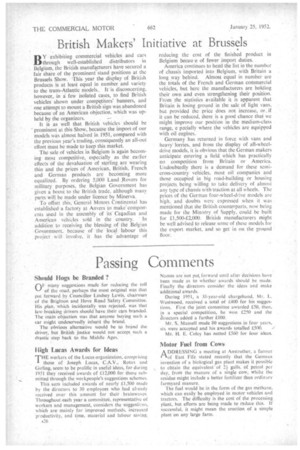British -Makers' Initiative at Brussels
Page 28

If you've noticed an error in this article please click here to report it so we can fix it.
BY exhibiting commercial vehicles and cars through well-established distributors in Belgium. the British manufacturers have secured a fair share of the prominent stand positions at the Brussels Show. This year the display of British products is at least equal in number and variety to the *trans-Atlantic models. ftis disconcerting, however, in a few isolated cases, to find British vehicles shown under compctitors' banners, and one attempt to mount a British'Sign was abandoned because of an American objection, which was upheld by the organizers. It is as well that British vehicles should be prominent at this Show, because the import. of our models was almost halved in 1951, compared with the previous year's trading, consequently an all-out effort must be made to keep this market.
The sale of vehicles in Belgium is again becoming most competitive,, especially as the earlier effects of the devaluation of sterling are wearing thin and the prices of American, British, French and German products are becoming more equalized. By ordering 5,000 Land Rovers for military purposes, the Belgian Government has given a boost to the British trade. although many parts will be made under licence by Minerva.
To offset this: General Motors Continental has established a factory at Anvers to make' cornpotreats used in the assembly of its Canadian and American vehicles sold in the country. • in addition to receiving the blessing of the Belgian Government. because of the local labour this project will involve, it has the advantage of reducing the cost of the finished product in Belgium becatre of. fewer import duties.
America continues to heard the list in the number of chassis imported into Belgium, with Britain a long way behind. Almost equal in number are the totals of the French and German commercial vehicles, but here the manufacturers are holding their own and even strengthening their position. Freint the statistics available it is apparent that Britain is losing around in the sale of light vans. but provided the price does not increase, or, if it can be reduced, there is a good chance thatwe might improve our position in the medium-class range, e-petially where the vehicles are equipped with oil engines.
Germany has returned in force with vans and heavy' lorries, and from the display of all-wheeldrive models, it is obvious that the German makers anticipate entering a field which has practically no competition from Britain or America. Undoubtedly there is a demand for these semicross-country vehicles, most oil companies and those occupied in big road-building or housing projects, being willing to take delivery of almost any type of chassis with tractional all wheels. The prices of the German four-wheel-drive models are high, and doubts were expressed when it was mentioned that the British counterparts, now being made for the Ministry of Supply, could be built for fl,50042,000. British manufacturers might be well advised to release some of these models for the export market, and so get in on the ground floor.




















































































